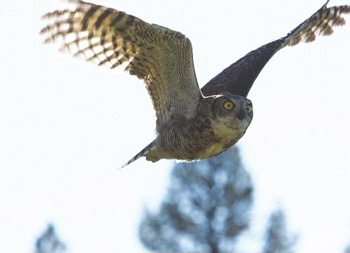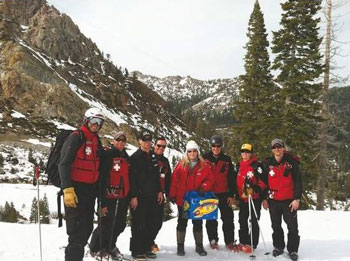Great horned owl released in Squaw Valley
By Amy Edgett
Thursday, April 19, 2012

SQUAW VALLEY, Calif. — Who, who, whoooo hobbled down Squaw Valley's Mountain Run early one March morning, to be discovered by groomer Craig Patterson? It was "Mr. Owl," as the Lake Tahoe Wildlife Care came to call it.
Patterson called dispatch and the great horned owl, (Bubo virginianus) was rescued by ski patroller Taylor Wood and Kyle Crezee, Squaw Valley's director of events.
same spot it was rescued March 3 by early morning groomer Craig
Patterson.
Photo courtesy BEAR League
 At first it was thought the owl suffered a broken wing and perhaps some leg damage — it also had blood on its face. It was treated and stabilized at the BEAR League's wildlife clinic for 24 hours, where it was determined he suffered a severe concussion but no other injuries.
At first it was thought the owl suffered a broken wing and perhaps some leg damage — it also had blood on its face. It was treated and stabilized at the BEAR League's wildlife clinic for 24 hours, where it was determined he suffered a severe concussion but no other injuries.
He was then transported to Lake Tahoe Wildlife Care in South Lake Tahoe for recovery. At first, it was not able to eat on his own, but within a week he could pick up food and began perching more gracefully, according to Ann Bryant, executive director of the BEAR League.
Ben Leech, Greg Hawes, Ann Bryant, Pete Charles, Crystal Winn
and Tom Paschos - all Squaw Valley ski patrollers except for
Bryant - who is Executive Director of the BEAR League.
Photo courtesy Squaw Valley USA
At the end of the week, he was taken to LTWC's enclosed outdoor flight cage, where he practiced and improved his flying skills.
After about a month, he no longer listed to the side during flight and plans were made for a release when window of good weather opened.
With the much appreciated help of Squaw Valley Ski Patrol, safely housed in a transport kennel and cradled in Bryant's arms, "Mr. Owl" traveled by snowmobile to the location where he was rescued.
"Oh, my gosh, he was huge, just enormous," said Bryant of the owl's 5 to 6-foot wing span. "You could hear the wind rushing through his wings as he gained altitude, whoosh, whoosh, whoosh as he lifted into the air. He obviously knew he was back home, veering slightly to the right and then gracefully gliding out of our sight."
Bryant said everyone was awed by the beauty of his flight and the thrill of his return to the wild. High fives were passed around in celebration.
Great horned owls are native to the Americas, with activities usually beginning at dusk. They hunt by perching and watching for prey, or gliding slowly above the ground. They will also hunt by walking on the ground for small prey or wading into water for frogs and small fish. Food includes rodents, mammals and birds and the occasional domestic dog or cat.
The BEAR League, a satellite of Lake Tahoe Wildlife Care, is the only wildlife facility legally allowed to rescue and care for wildlife from Truckee and the North and West Shores. They can be reached for emergencies 24/7 at 530-525-7297. Visit www.savebears.org for news, events and information about living in bear country.
In South Lake, contact the Lake Tahoe Wildlife Care, Inc., 1485 Cherry Hills Circle, South Lake Tahoe, 530-577-2273 or visit www.ltwc.org.
— Information from Amelia Richmond, Squaw Valley USA and Ann Bryant, BEAR League and www.owlpages.com
